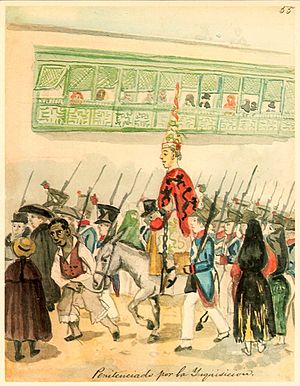Peruvian Inquisition facts for kids
The Peruvian Inquisition was a special court that existed in Lima, the main city of the Viceroyalty of Peru, from January 9, 1570, until 1820. This court was part of a larger system called the Holy Office of the Inquisition, which aimed to protect the Catholic faith.
Contents
History of the Peruvian Inquisition
Unlike the Spanish Inquisition or the Medieval Inquisition, the Peruvian Inquisition needed approval from the King of Spain to make its decisions. Both the government and the church had to work together.
Records from the Inquisition show that they created ways to find people who were believed to be Jews, Lutherans (a type of Protestant), or Muslims. People from these groups were often punished for their beliefs.
The Peruvian Inquisition was first closed down in 1813 by a special government order. It was started again in 1815, but this time it focused more on new ideas from thinkers like the French Encyclopédistes. Most people accused during this time were given probation, meaning they had to follow certain rules but weren't usually put in prison.
The Inquisition eventually ended on its own as the country moved towards independence. This happened when Freemason José de la Serna became the viceroy, and different groups in Peru were getting ready to fight in the Peruvian War of Independence.
Who the Inquisition Judged
At the beginning, the Peruvian Inquisition mainly focused on people from Europe living in Peru. This included "old Christians" (people whose families had been Christian for a long time) and some descendants of converts, especially those with Jewish backgrounds, who had come to Peru even though it was against the rules.
It's important to know that most of the people in Peru were indigenous (native) people. They were new to Christianity, so the Inquisition usually did not have power over them, as decided by the kings of Spain.
Interestingly, a large number of foreigners were also judged by the Inquisition. This was partly because the government wanted to control possible spies from countries that were enemies of Spain.
Here's a look at the groups of people who were judged:
| ETHNIC GROUPS | NUMBER OF CASES | PERCENTAGE |
| Spaniards | 391 | 78.57% |
| Foreign people | 86 | 17.30% |
| Mestizo, black, and mulatto people | 21 | 4.13% |
| Total | 498 | 100.00% |
Most of the punishments given were "abjurations," which meant the accused person had to formally deny their supposed errors. About two-thirds of those judged (173 people, or 67%) had to do this. They also often had to pay fines or cover the costs of their trials.
Some people were "reconciled" (30 people) or "acquitted" (29 people), meaning they were cleared or forgiven. Eight cases were stopped before a decision was made.
A small number of people faced the most severe penalties. Six people were condemned, and nine effigies (statues or images) were burned. Burning an effigy was a symbolic punishment for someone who had died or could not be found.
Reasons for Severe Penalties (1569-1820)
Here are the main reasons why people faced the harshest punishments from the Court of Lima:
| REASON FOR ACCUSATION | NUMBER OF CASES | PERCENTAGE |
| Judaizers (people suspected of practicing Judaism) | 23 | 71.88% |
| Protestants | 6 | 18.75% |
| "Proposiciones" (spreading ideas against the faith) | 2 | 6.25% |
| "Alumbrados" (a group with specific spiritual beliefs) | 1 | 3.12% |
| Total | 32 | 100.00 |
See also
 In Spanish: Inquisición peruana para niños
In Spanish: Inquisición peruana para niños
- Mexican Inquisition
- Palace of Inquisition
- Manuel Bautista Pérez


